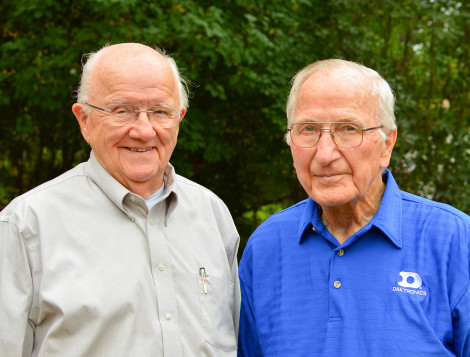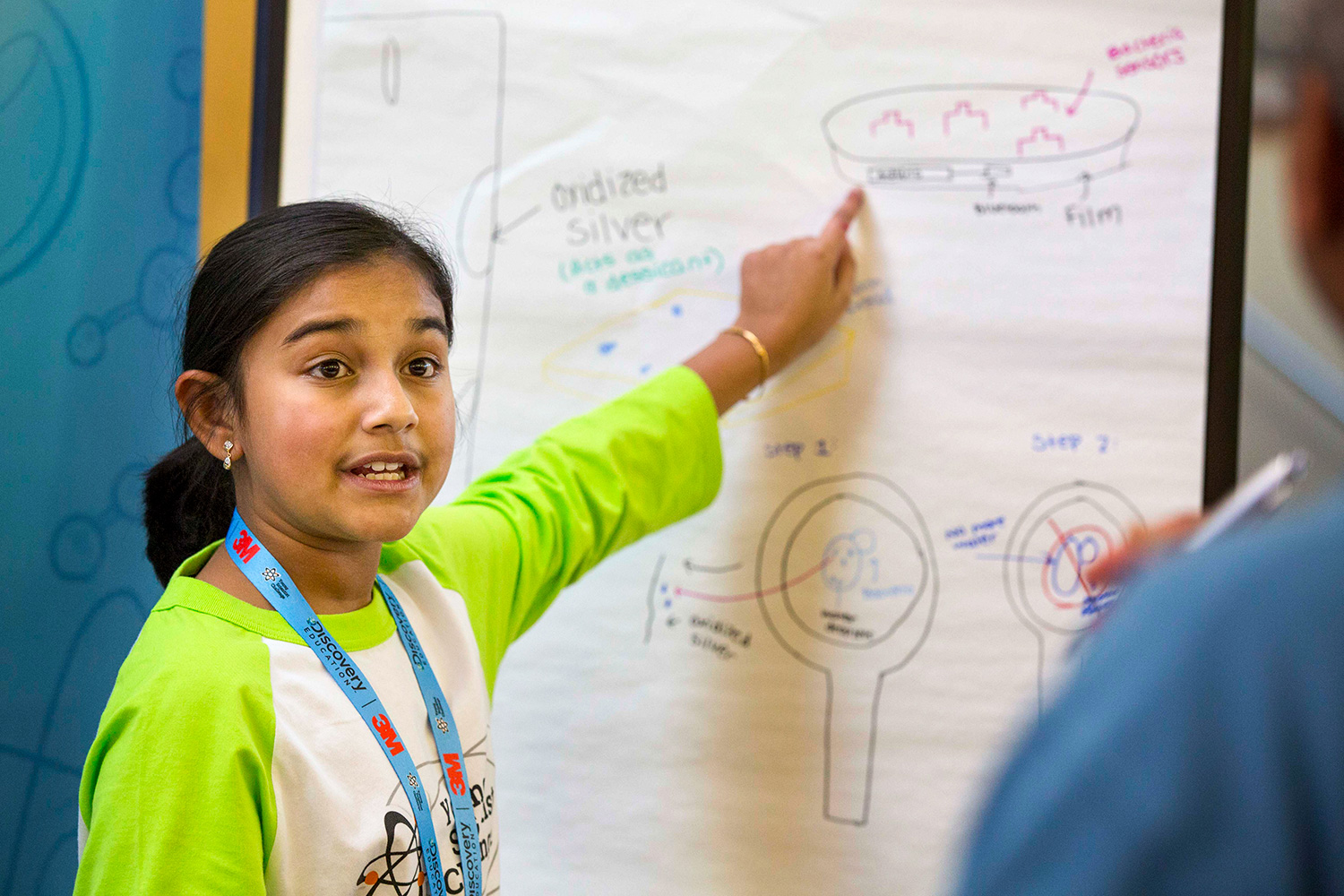
One girl's commitment
At 16 years old, Gitanjali Rao has invented a device to detect lead in water (inspired by the crisis in Flint, Michigan), an anti-bullying app, and was named TIME’s first “Kid of the Year” in 2020, among other notable accomplishments. But with her laser-focused commitment and a personality that “sparkles,” what makes her really unique is her ability to encourage other kids to realize their full potential.
16 min read
Each month, our Journeys of Innovation series tells the stories of inventors or entrepreneurs who have made a positive difference in the world. This month, we focus on the journey of an accomplished young woman who is determined to use science for kindness.
As she walked across the auditorium in 2017, Gitanjali Rao was silently screaming with joy. With each step her thoughts quickened, her vision cleared; it was like a fog of uncertainty was lifting at last. She was only eleven and the youngest at the competition, but her project had worked. Out of hundreds of entries, hers had won the prize!
This was no school auditorium, and Anjali, as she is known to friends and family, was no ordinary seventh grader. The stage she now approached, hands trembling, was at the 3M Customer Innovation Center in St. Paul, Minnesota, and the finalists’ inventions for the Discovery Education 3M Young Scientist Challenge had included everything from cancer diagnostic tools using 3D printing and machine learning, to pomegranate husk and orange-peel compositions for oil spill remediation, to Rao’s own device, which she called the Tethys, that used carbon nanotubes to detect lead in water—the kinds of innovations that could, quite literally, change the world.
To Rao, the possibilities seemed endless.
“Our generation is … seeing problems that have never existed before,” she says, “so we can’t be afraid to dream big.”
Incredibly, for someone who was 3M’s “America’s Top Young Scientist” of 2017 and TIME’s first "Kid of the Year" in 2020, Rao hasn’t always considered herself the “science type”.
When she was three, she accompanied her mother to a nursing home to visit a family friend. A caring kid, she was overwhelmed with concern by what she experienced there. The patients seemed sad. Her mother suggested music might cheer them up.
Wanting to do just that, Rao began to practice piano. A year later, carrying her Suzuki handbook and sitting down on a stool in the nursing home, she serenaded the residents with “Old MacDonald Had a Farm.” Smiles everywhere confirmed her success, and it soon became a weekly activity.
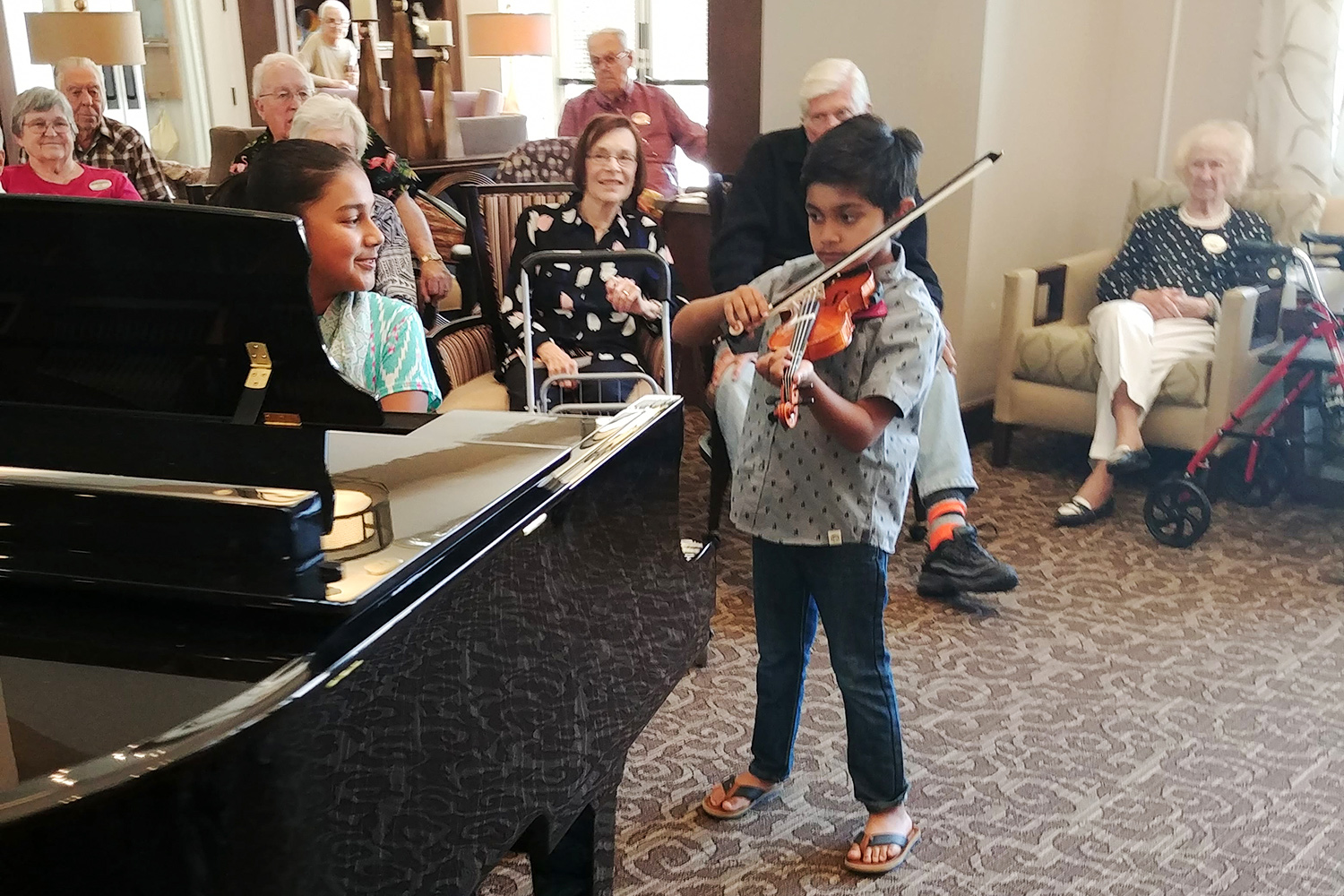
After many years of solo piano serenades for residents of a local nursing home, Rao, left, is joined by her brother Anu, on violin.
To encourage and support their children’s aspirations, to help them “dream big,” her parents challenged Anjali and her brother Anirudh, or “Anu,” in a variety of ways. When her mother asked them to pick one principle that each would adhere to in life, Rao chose commitment.
“Sometimes I commit without knowing how I will do it and, magically, just the principle helps me reach the end,” says Rao.
Her parents also created games to challenge them. Starting with familiar concepts like a zoo, hotel, or a restaurant, a common request was to pitch an idea for a business or invention they had never heard of before. The rubric for these playful competitions was tough.
With their own impressive resumes in the IT sector and strategic project management, one of Gitanjali's parents would judge on creativity, communication, technology, and user experience, while the other played the game, so the competition was stiff. To the winner would go the spoils, something as high stakes as an ice cream.
“We are a weird family,” Rao admits with a laugh.
“Looking back, we didn’t think this would lead to anything, other than they will grow up to be responsible citizens,” says Rao's mother on how she and her husband felt about these challenges. Both found the games useful in understanding their children’s passions. At five, Rao’s was robots and drones, which she would add to every pitch, no matter how unrealistic it made them.
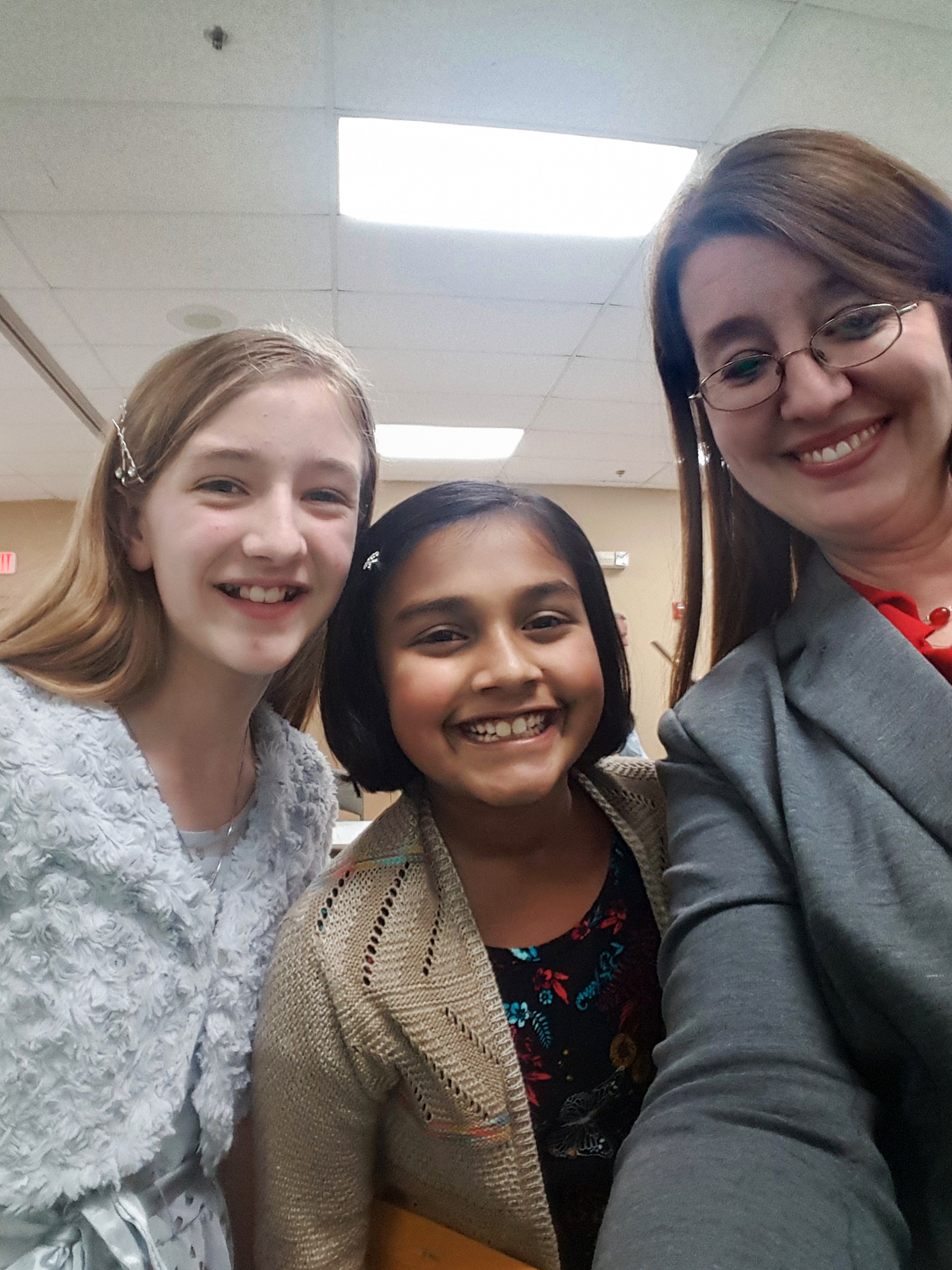
Rao, center, poses for a photo with Jennifer Hartsell Stockdale and her daughter Lauren at the Williamson County 2016 4-H Awards Banquet in Tennessee. (Photo courtesy of Jennifer Hartsell Stockdale)
With encouragement from her parents, Rao entered the 2012 Spark READiness Freedom to Read Essay Contest. She was scared of failing, but ended up winning second place with an essay about her favorite book, "Ella Enchanted," a retelling of Cinderella built around the theme of selflessness. This led to her meeting event sponsor, lawyer Jennifer Hartsell Stockdale.
“Right away I identified Anjali as an extraordinary second grader in her intellectual abilities, her ambitions, her oral and written communication skills, her ‘big picture’ thinking, and her enthusiasm for learning,” says Stockdale. “But when it comes down to it, it's her smile and laugh that I remember most. She has so much charisma that she nearly sparkles!”
After working with Stockdale on a variety of writing projects the following summer, Rao, inspired by her brother Anu’s love of spiders, took her new skills and wrote, "Baby Brother’s Wonders." She illustrated it and entered it in a PBS Kids contest, and won 2nd place. The book was published in 2015.
Recognizing her growing interest in science, Stockdale encouraged Rao to join her 4-H STEM Fun class, where Rao would be both a student and an assistant.
“She was the only student who showed up with a lab coat—the girl meant business!” says Stockdale. “Her questions demonstrated that she was thinking about the material differently than the other students.”
One day, after Stockdale’s electrician father came to class and taught the students how to solder, Rao proudly held up her project, a soldered weevil with flashing L.E.D. eyes. Little did anyone know, she would soon be using these newfound skills for her award-winning Tethys prototype.
One night in 2014, when she was nine, Rao was eating a spaghetti dinner with her family and the news was playing in the background when she heard someone say, “Flint, Michigan is facing a crisis of lead-contaminated tap water …”
Turning her attention to the TV, Rao saw images of rust-colored water and people with rashes and patchy scalps. Worse, she heard talk of children with brain damage, all due to the lead in their drinking water.
Rao took a sip from her glass.
“So in Flint, the water I’m drinking would have lead in it?”
“Yes,” said her mother, with equal concern. The Raos often listened to the news during dinner and encouraged their children to discuss current events.
Lost in thought, Rao quickly finished dinner and got ready for bed, but she had a hard time falling asleep. Clean water is a basic human right, she thought, but the water in Flint was poisoned. Those kids were her age. It didn’t seem fair - or right.
When she awoke the next morning, Rao made a vow: she would find a way to help, and not by collecting money or donating water. Still in search of a solution a year later, at age 10, Rao was reading the "MIT Technology Review"—the cover of which happens to be the lock screen image on her smartphone—when she came across an article on carbon nanotubes. They were used to detect food spoilage through resistance created by gases in air, she read, but could they also work to detect lead in water? Rao wasn’t sure, so she jotted it down in her journal, adding it to a growing list of ideas. Some, like her idea of adding bacteria that could detect and “eat” the lead in water by binding to it, she now calls “crazy.” Though it could technically work, the water would still have the equally dangerous bacteria in it.
Around this time, Rao watched her parents test the water in their Nashville, Tennessee home. Surprisingly, some test strips showed the water was safe while others indicated lead was present. Clearly this method was not 100% accurate or reliable.
Consumed by the same desire to help she had felt since that first day at the nursing home, when she was three, Rao spent hours a day, for months on end, delving into possible solutions. After many dead ends, she circled back to the idea of carbon nanotubes detecting lead.
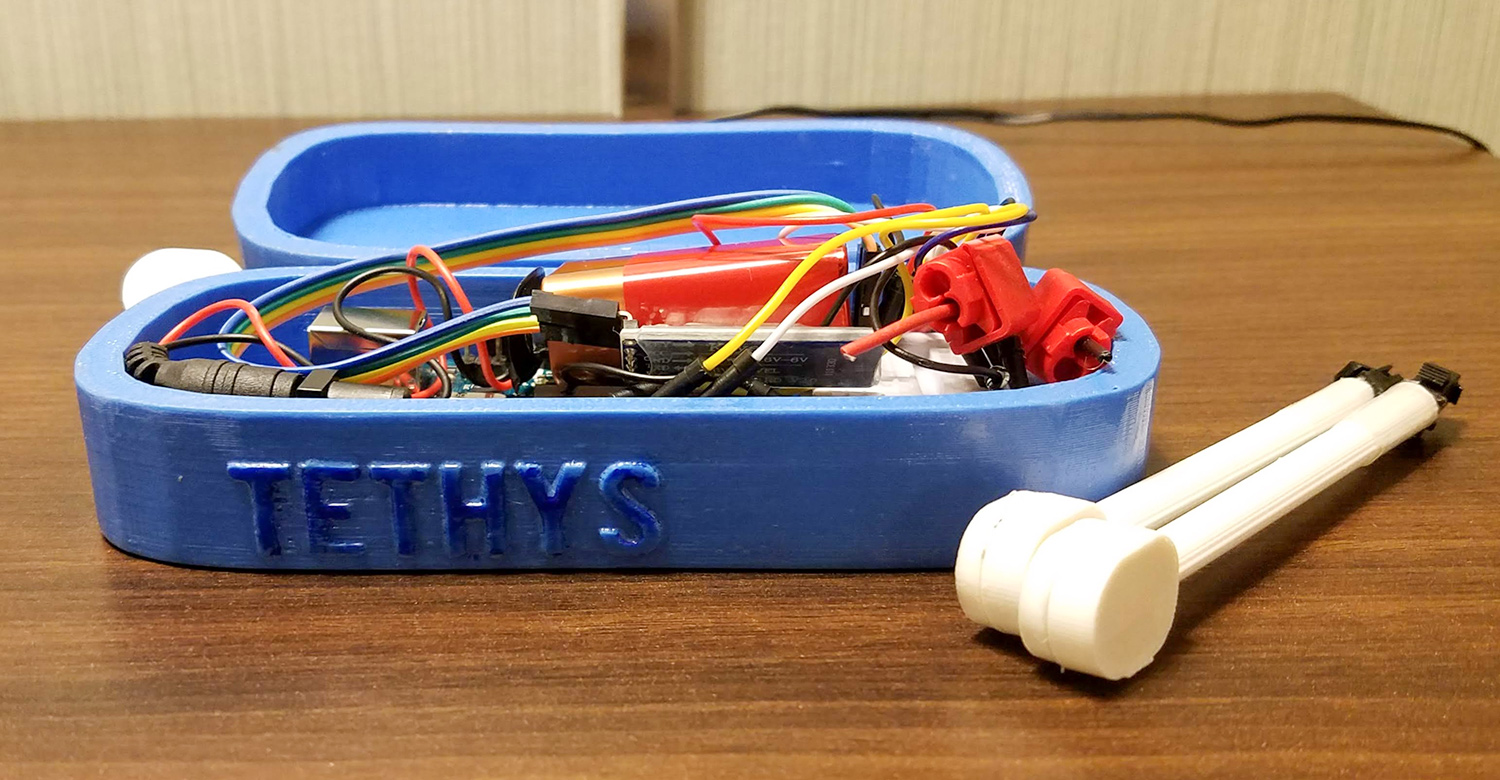
Rao’s finished prototype for the Tethys included a 3D-printed frame, a chloride-doped carbon nanotube sensor, and an Arduino internal processor. If lead is present in water, it binds to the nanotube and creates resistance. Tethys measures that resistance and sends the data to a smartphone app, which alerts the user to the presence of lead.
Unsure whether she could make the sensors work, or even who to ask for help, Rao decided to enter the Discovery Education 3M Young Scientist Challenge, which she had heard about through her 4-H STEM Fun class with Stockdale. It required applicants to make a one-to-two-minute video in which they describe an invention that could solve or impact an everyday problem directly affecting them, their families, their communities, or the world. If nothing else, Rao figured, the feedback from 3M could be valuable. At the last minute, she added a 3D-printed frame and an internal processing system to the conceptual device in her video pitch. She called it Tethys, after the Greek goddess of fresh water.
Without access to a proper lab, Rao started building the prototype on her own. The frame she made from cardboard, and she learned to code an Arduino microcontroller through online tutorials. Happy with her progress, there was still the daunting challenge of how to get her hands on working carbon nanotubes. Cold-emailing dozens of scientists only led to more dead ends; few replied, and overwhelmingly they couldn’t help.
But fate was on Rao’s side. Just when it seemed she was out of options, the phone rang. It was 3M; Rao had made it to the finals! Even better, she was paired with a real scientist, Dr. Kathleen Shafer, a research specialist in 3M’s Corporate Research Materials Laboratory. Rao was elated but anxious. In the summer of 2017, one of her parent's jobs required a family move to Lone Tree, Colorado, just outside of Denver. Rao had no idea how she would get her prototype ready while her life was temporarily uprooted by the move.
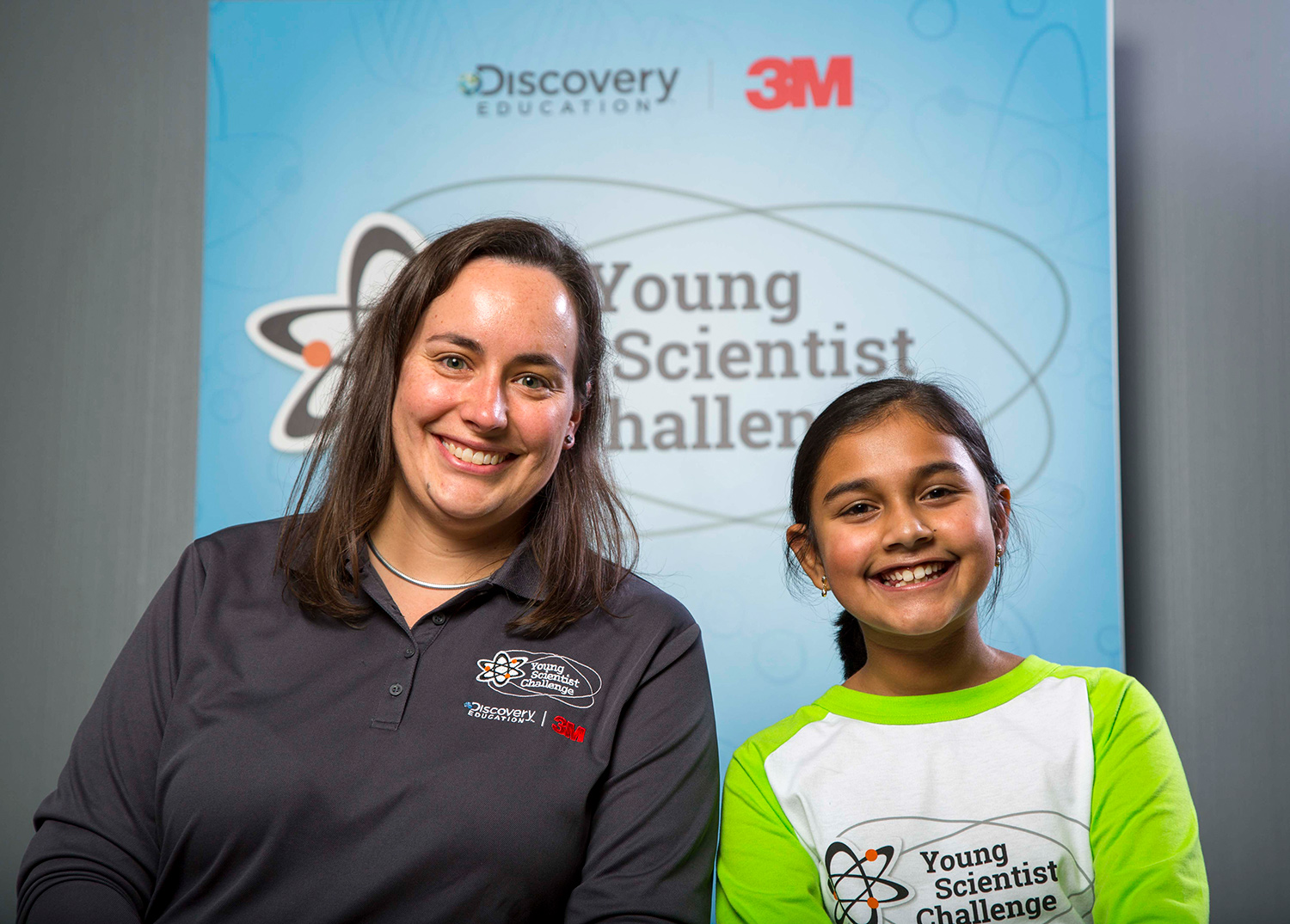
Rao and her mentor Dr. Kathleen Shafer pose for a portrait during the 2017 Discovery Education 3M Young Scientist Challenge in St. Paul, Minnesota. The two were partnered and Shafer worked virtually with her over the summer leading up to the event to help develop her invention. Rao was awarded the title of “America’s Top Young Scientist” and received a $25,000 prize. (Photo Courtesy of 3M and Discovery Education, 2017)
Eager to help their kids adjust, Rao’s parents signed her up for a coding camp in Colorado.
“We moved schools and cities many times,” says Rao, whose parents always ensured that her extracurricular activities were lined up before they arrived in their new home. “There was a comfort feeling of knowing [of] your friend groups before you meet them.”
Excited, she walked into class the first day and found that she was the only girl in a roomful of boys. When her team began to code their game and Rao’s teammates proposed only male characters, she spoke up. It was just an oversight on their part, but one that highlighted to Rao the challenges of being a girl or a young woman in STEM.
Unfazed by the dead ends in her search for carbon nanotubes, a cross-country move, and the unconscious male biases in STEM, Rao stayed positive. Still obsessed by the predicament of the people in Flint, Michigan, she spent her time during house showings and hotel stays at the library reading. Shafer helped Rao maintain momentum and focus on possible Colorado-based resources.
Thankfully, her new school had a 3D printer, and with components like wires and adhesives provided by 3M, Rao began building a proper prototype. With encouragement from Shafer and her parents, she kept reaching out and eventually found Mike Foley, a Vermont-based manufacturer who was nice enough to provide her, at a discounted price, the special chloride-doped nanotubes that could detect lead.
After years of ideation, Tethys was finally becoming a reality. Marveling at how this happened, Rao began to realize that it was okay to ask for help and to consult experts and mentors when she was stuck. Innovation didn’t have to be a solitary activity; sometimes, it was a team effort.
“She is an amazing example of the impact of programs like the Young Scientist Challenge,” says Shafer. “[It] provides both an avenue for students to consider how they can make a difference through science, as well as a unique mentorship experience to support them in their efforts."
Those efforts, supported and guided by mentors like Shafer, not only helped Rao win the 2017 3M Young Scientist Challenge; they also landed her a patent. On August 10, 2021, at the age of 15, Gitanjali Adhikarla Rao was granted U.S. Patent No. 11,085,907 for a “system and method for detecting contaminants in water.”
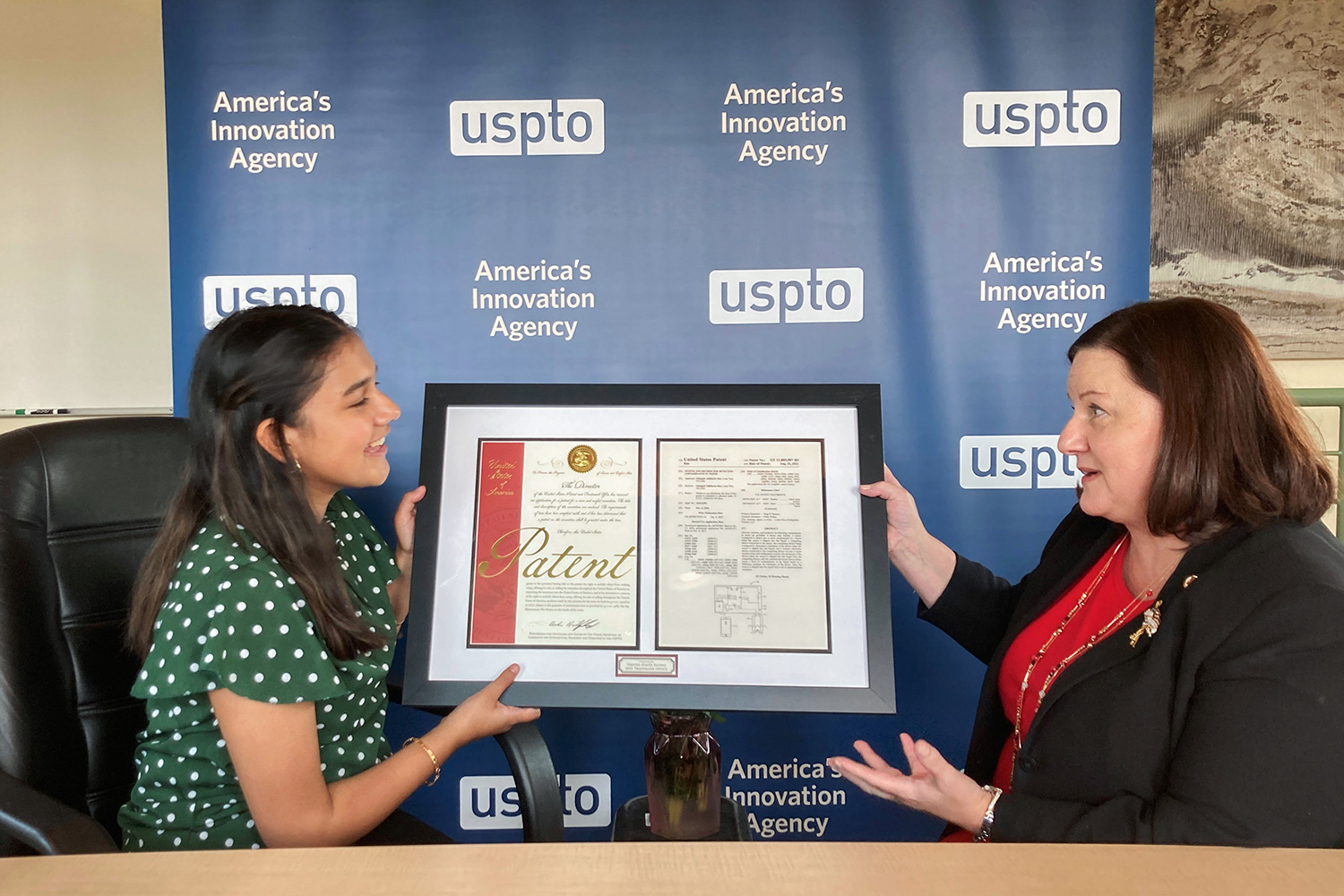
Gitanjali Rao was granted U.S. Patent No. 11,085,907 on August 10, 2021 for her “system and method for detecting contaminants in water.” Mollybeth Kocialski, director of the USPTO’s Rocky Mountain Regional Office in Denver, Colorado, right, presents her with a framed copy during the USPTO's annual Invention-Con, a conference for independent inventors, entrepreneurs, and small business owners. (Photo by USPTO)
By then, Flint’s water crisis was nearly over. After close to $400 million in state and federal spending, the city had secured a clean new water source, distributed filters to every resident who wanted one, and installed safe, modern copper pipes to nearly every home that needed them.
Bolstered by the lessons she had learned working on the Tethys, which could still avert future crises like Flint’s, Rao was tackling new challenges. After learning of a family friend who became addicted to prescription opioids after a car accident, Rao began to read about opioid addiction.
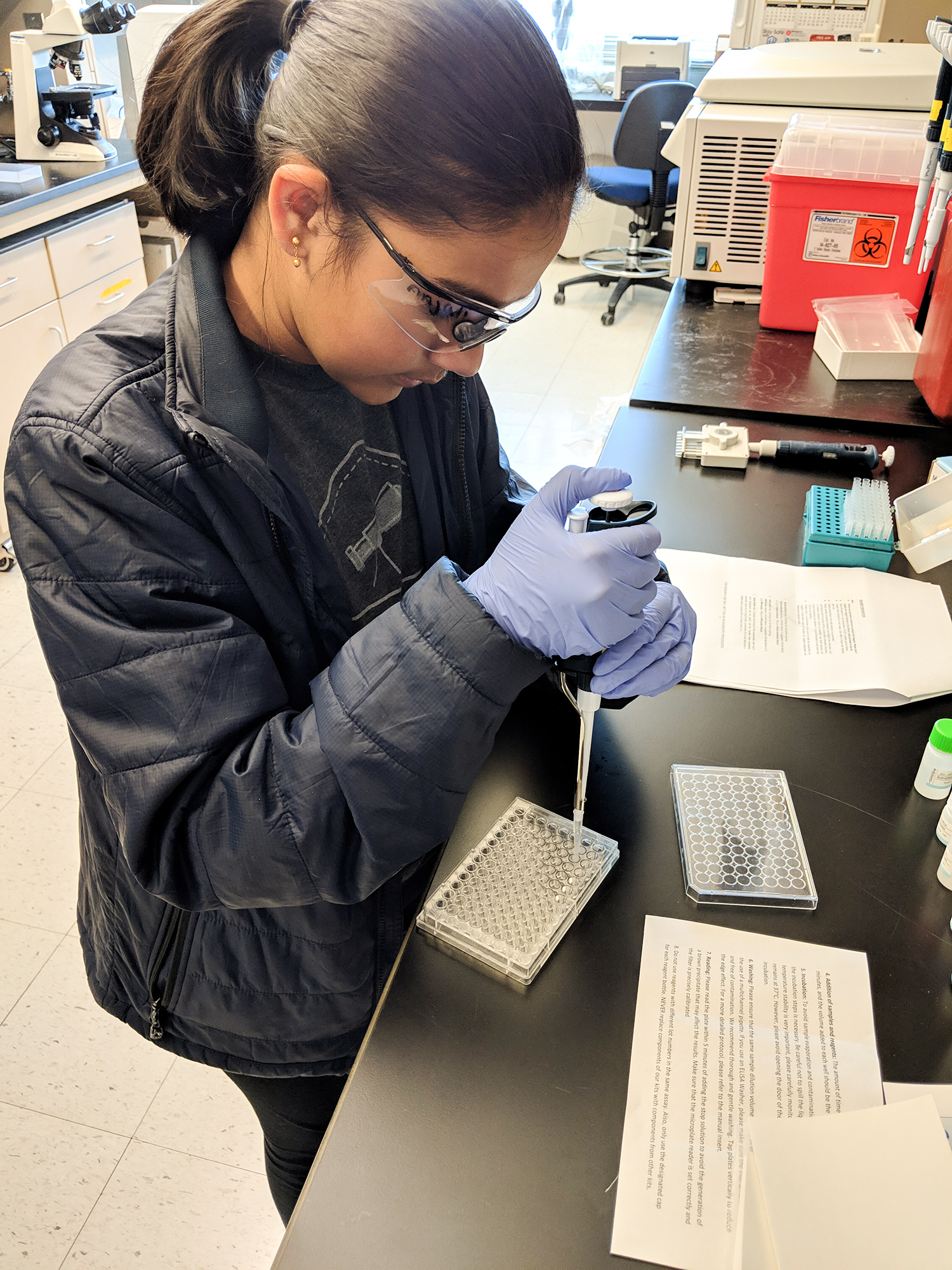
Rao works on polymerase chain reaction (PCR) in Dr. Michael McMurray’s lab at the University of Colorado School of Medicine.
She learned that mutations in the opioid receptor gene could make people more sensitive to painkillers. Further, the same polymerase chain reaction (PCR) now familiar around the world, because of COVID-19 PCR tests, could detect this mutation. Rao’s goal was to make a handheld device someone could use at home to tell if they were likely to get addicted. Not being a geneticist, but a soon-to-be eighth grader, she needed help, and this time she didn’t hesitate to seek it out.
She was put into contact with Dr. Michael McMurray, a professor in the Department of Cell and Developmental Biology at the University of Colorado School of Medicine.
“I remember meeting Gitanjali for the first time and being amazed at how quickly she picked up information as we talked about PCR,” says McMurray, who jumped through hoops to get the 13-year-old a keycard to the university’s lab.
At McMurray’s suggestion, they decided to use yeast cells for their experiments, to avoid the regulatory hurdles that come with human DNA. After discussing what types of sensors might be best, Rao showed up one day with a 3D-printed spectrophotometer she had already programmed. It worked by taking a sample picture and comparing it to images in an app. A darker color would indicate a mutation that causes increased protein and therefore a higher likelihood of addiction.
Rao called the device Epione, after the Greek goddess of relieving pain.
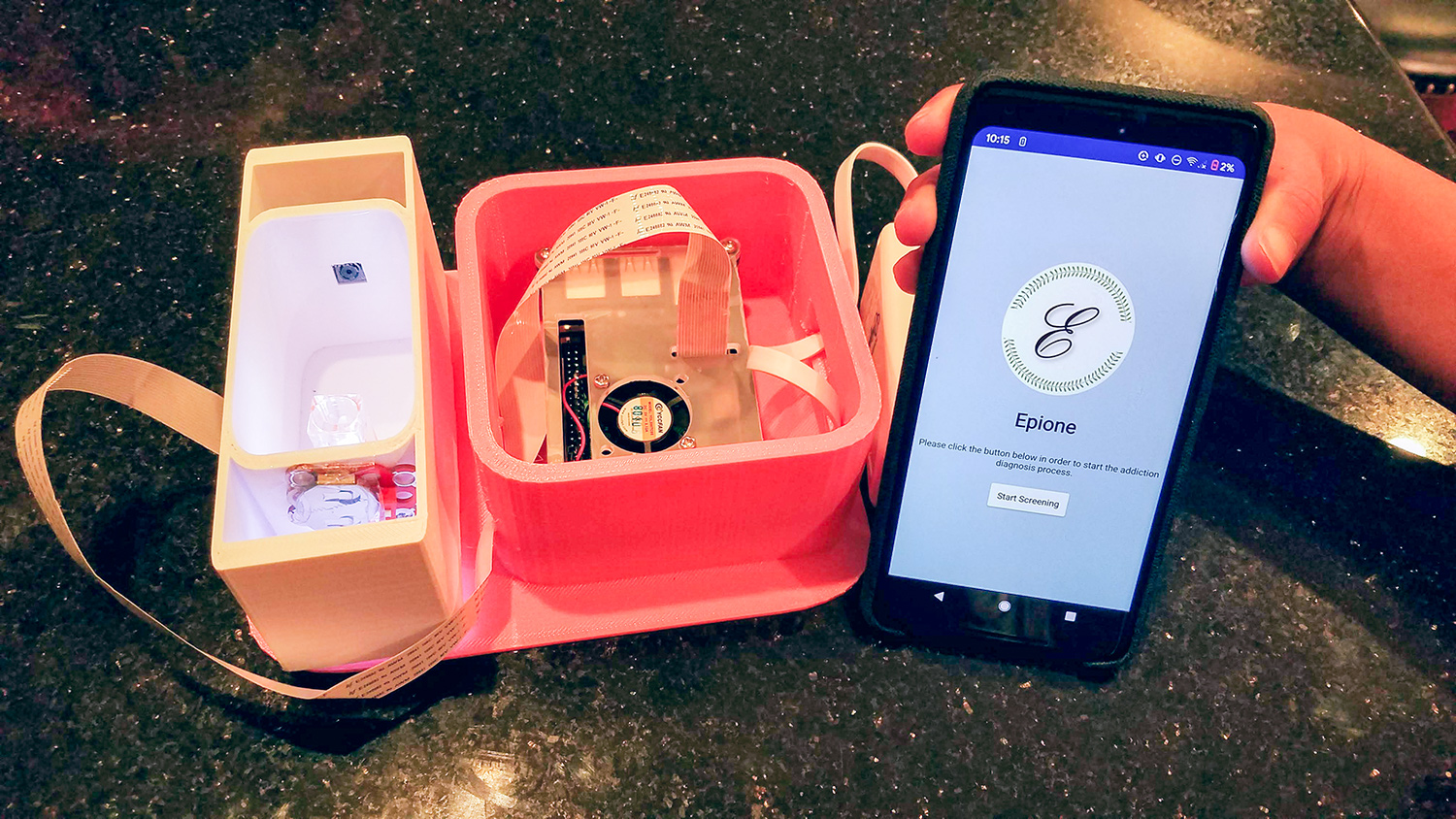
Rao’s prototype for Epione includes a 3D-printed frame and an immunoabsorbent testing element that, when linked with an app, allows the user to diagnose opioid addiction at an early stage.
Now she needed to test it. Hitting roadblocks with the PCR technique the team planned to use, they came across an article on CRISPR-Cas9, a versatile gene-editing technology that can modify, delete, or correct precise regions of human DNA. Rao had heard of it already, and she was dying to try out. It would be a first for McMurray’s lab as well. But then came the coronavirus pandemic, which has restricted their access to the lab since early 2020.
Rather than sit and wait, Rao took an internship with the Attorney General’s Office of Colorado, where she helped develop an opioid response plan and influence funding. She hopes to get back to the lab this spring.
“I was always impressed with her patience and persistence,” says McMurray. “She was always able to move forward without being defensive or frustrated.”
Rao has moved forward on other fronts as well. After moving to Colorado, she worked on a group project at school in which her team considered the subject of bullying. Using the MIT app Inventor 2, they designed a prototype called Kindly in which a user could type a sentence, and an AI algorithm would flag if the wording had a bullying intent. Rao and her teammates wanted to test it, so they headed to Mrs. Kelly Thatcher’s classroom, where Anu was a student.
“They would come in and would talk with the children about how you make an app, how to treat people well, and what kinds of things could be construed as hurtful or building people up. If she needed honest feedback, from the most honest people of the world, kindergarteners, she would come and bounce that off us,” says Thatcher.
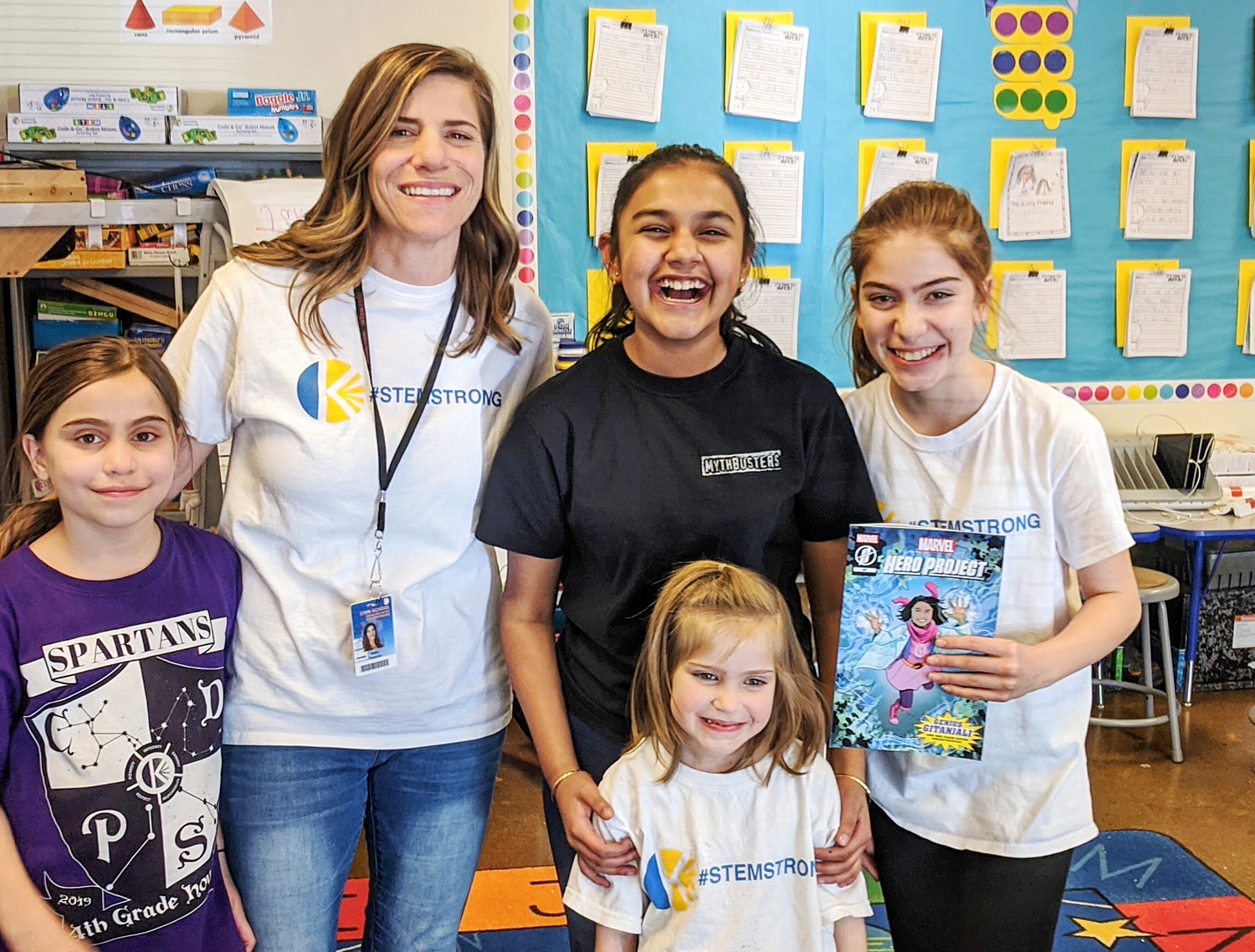
Kelly Thatcher, a kindergarten teacher and alumna of the USPTO’s National Summer Teacher Institute (NSTI), poses with her three daughters and Rao in May of 2019 to celebrate Rao's being featured in a comic book as part of the Marvel Hero Project. Rao, who had worked with Thatcher and her students for a number of years, autographed copies of the comic book. (Photo Courtesy of Kelly Thatcher)
After the group’s project was complete, Rao decided to take Kindly even further. It has now launched through partnership with UNICEF, and anyone can contribute to Kindly’s self-learning algorithm through its open-source AI model.
“One girl cannot solve all of the world’s problems,” says Rao, who recognizes and appreciates the role that her parents, mentors, and peers all played, and still play, in her achievements and success. “That’s exactly why I’m hoping to solicit new innovators into the world of STEM.”
At Thatcher’s invitation, when she was still new to Colorado, Rao helped run innovation sessions in her classroom. Soon after, the 3M challenge award gave her a platform and she started thinking about the impact she could have on others.
Driven by a newfound purpose of jump-starting innovation for others, Rao starts her days at 5:45 a.m., often working before school and hosting self-run innovation sessions for rural communities during study halls. Sometimes she conducts workshops as late as 9 p.m. for students in Japan, Cambodia, or India. Now a student at both STEM School Highlands Ranch and the University of Colorado, these activities are all in addition to normal things like her homework.
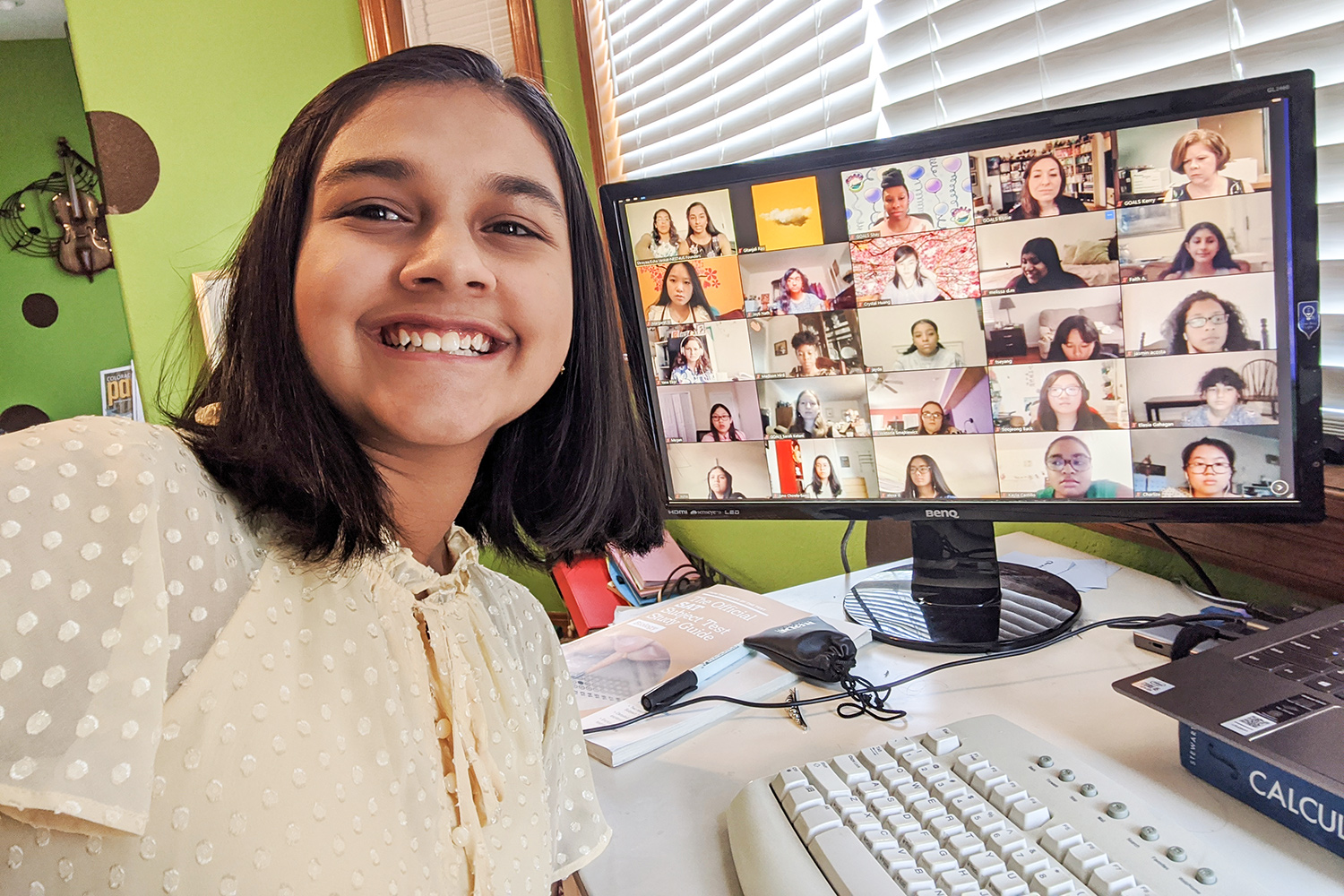
Rao pauses during an online event to take a photo with the participants. Motivated to use “science for kindness,” Rao encourages other kids to identify their passions and actively seek help and support so they, too, can achieve great things.
“I try to do everything at a pace that keeps things exciting,” says Rao of her extracurricular activities.
Having now reached over 58,000 students in 37 countries, and realizing that her time is limited, she released “A Young Inventor’s Guide to STEM” in March of 2021. The book details her innovation strategies in depth.
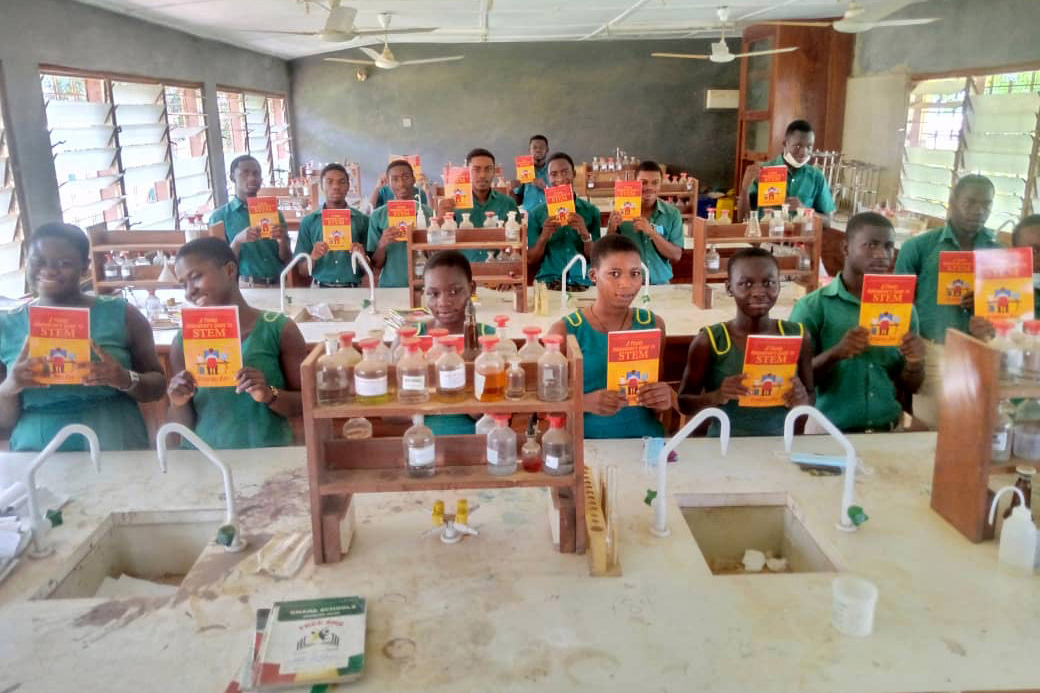
Students at New Abirem-Afosu Senior High-School in Ghana hold up copies of Rao’s book, “A Young Innovator’s Guide to STEM,” published in March of 2021. Recognizing that not all people have the same access to critical resources, Rao hopes the book inspires and demystifies the innovation process for others.
After becoming a 2021 Young Explorer for National Geographic, Rao was awarded a grant and invested it in improving a maker space at the Kakuma refugee camp in northwest Kenya where students create, problem solve, develop, and construct new ideas. Through copies of her book and the laptops and chairs she provided, the children of the camp have been able to start taking STEM classes.
At 16, Rao is now a confident young woman who is not afraid to blaze her own trails. Continuing to involve herself in whatever opportunities present themselves along the way, time permitting, she says, “I have a long journey to go in influencing a K-12 education curriculum that includes innovation, but I believe I am on the right path with the right support.”
And having accomplished so much at an age when she is still not old enough to vote, Rao’s plans for the future are naturally in flux. While she has her eye on a career in biotech or genetics, she wouldn’t rule out starting a business.
“I have a newfound appreciation for entrepreneurship,” she says, “and that honestly comes from applying for my first patent and thinking, this is so fun!”
Rao remains kind, generous, and personable to everyone she encounters, but what really stands out is her compassion and her desire to increase opportunities for everyone.
“Remember, truly, if you are interested in making a difference in the world, there are no deadlines. As long as you are working towards making a difference,” she says, “you are.”
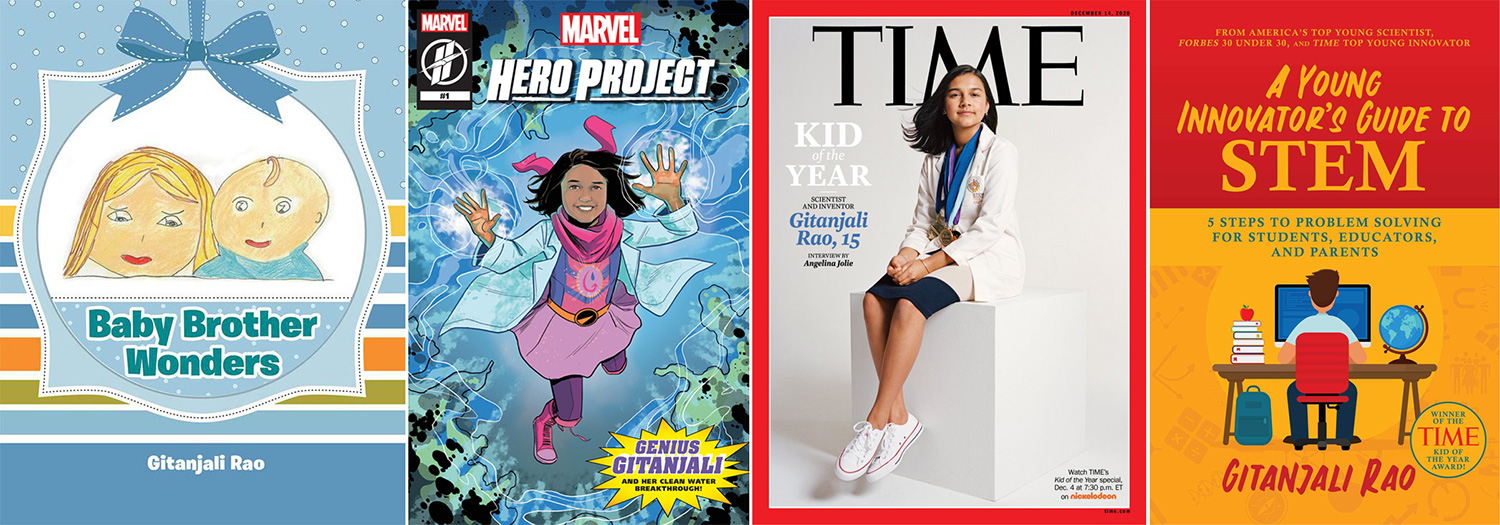
Rao’s book "Baby Brother Wonders," which she wrote for her brother Anu; the 2019 Marvel comic book she was featured in; the cover of TIME’s December 2020 issue, which named her their first ever Kid of the Year; and "A Young Innovator’s Guide to STEM."
Credits
Produced by the USPTO Office of the Chief Communications Officer. For feedback or questions, please contact inventorstories@uspto.gov.
Story by Rebecca Fritchman. Contributions from Jay Premack and Eric Atkisson. Special thanks to Gitanjali Rao & family, Kelly Thatcher, Jennifer Hartsell Stockdale, Michael McMurray, Kathleen Shafer, and Mollybeth Kocialski.
Photo at the top of this page courtesy of 3M and Discovery Education, 2017. It features Gitanjali Rao, giving her presentation at the 3M Discovery Education 3M Young Scientist Challenge finals to a lecture hall full of distinguished scientists, on October 17, 2017.
Photos unless otherwise indicated courtesy of Gitanjali Rao.
References
Rao, Gitanjali. (2021). A Young Innovator's Guide to STEM. Post Hill Press.
TIME staff, “Meet TIME's First-Ever Kid of the Year.” Time.com, December 3, 2020 6, https://time.com/5916772/kid-of-the-year-2020/.
3M, Hall, K., Hanson, M., "11-year-old scientist is developing a solution to help solve the water crisis in Flint, Michigan."https://www.3m.com/3M/en_US/particles/all-articles/article-detail/~/clean-water-lead-detection-young-scientist-challenge/?storyid=e8ea94e9-95b7-448a-bd74-79fbbb0a5960.


